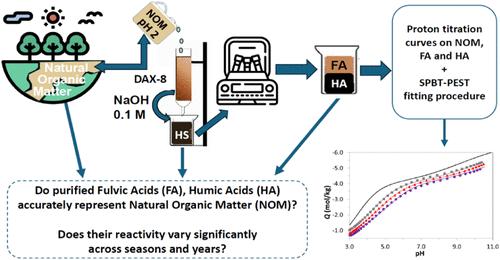评估分离腐殖质的代表性来模拟水生有机物的反应性:质子结合研究
IF 11.3
1区 环境科学与生态学
Q1 ENGINEERING, ENVIRONMENTAL
引用次数: 0
摘要
本研究探讨了富里酸(FA)和腐植酸(HA)在表征河流溶解有机质(DOM)季节和年度反应性中的代表性。因此,质子滴定对来自Sorocabinha河和Itapanhau河(巴西)的样品进行,重点是纯化FA和HA组分,浓缩腐殖质物质(HS)和未经处理的河水。结果表明,在干旱和雨季以及年份(2014年和2022年),来自两条河流的纯化FA/HA的质子结合特性是一致的,这表明纯化的潜在平均效应可能会掩盖天然DOM的变化。在2022年观察到FA/HA与其亲本HS之间的质子反应性存在显著差异,突出了单独表征的必要性,这是文献中有时忽略的一个方面。值得注意的是,未经处理的Sorocabinha河水的质子亲和谱呈现出三个峰,而纯化的FA/HA则呈现出两个峰,这与其他主要河流中亲水性酸部分(HPI)的存在一致。因此,我们认为,在存在HPI的情况下,仅依靠FA和HA反应性参数来建模DOM(例如,风险评估)是不准确的。我们提倡未来的研究,通过解决基于FA/ ha方法的局限性,并在必要时制定现实的替代方案,来改进DOM建模。本文章由计算机程序翻译,如有差异,请以英文原文为准。

Assessing the Representativeness of Isolated Humic Substances to Model the Reactivity of Aquatic Organic Matter: A Proton-Binding Study
This study explores the representativeness of fulvic acid (FA) and humic acid (HA) in characterizing the seasonal and annual reactivity of riverine dissolved organic matter (DOM). Consequently, proton titrations were performed on samples from the Sorocabinha and Itapanhau Rivers (Brazil), focusing on purified FA and HA fractions, concentrated humic substances (HS), and untreated river water. The results demonstrated consistent proton-binding properties of purified FA/HA from both rivers across dry and rainy seasons and years (2014 and 2022), suggesting a potential averaging effect from purification that may obscure natural DOM variations. Significant differences in proton reactivity were observed between FA/HA and their parent HS in 2022, highlighting the necessity for separate characterization, an aspect sometimes overlooked in the literature. Notably, the proton affinity spectrum for untreated Sorocabinha River water exhibited three peaks, in contrast to the two peaks for its purified FA/HA, consistent with the presence of a hydrophilic acid fraction (HPI) also evidenced in other major rivers. Accordingly, we argue that relying solely on FA and HA reactivity parameters for modeling DOM in, for example, risk assessment, is inaccurate in the presence of HPI. We advocate for future research to improve DOM modeling by addressing the limitations of the FA/HA-based approach and formulating realistic alternatives when necessary.
求助全文
通过发布文献求助,成功后即可免费获取论文全文。
去求助
来源期刊

环境科学与技术
环境科学-工程:环境
CiteScore
17.50
自引率
9.60%
发文量
12359
审稿时长
2.8 months
期刊介绍:
Environmental Science & Technology (ES&T) is a co-sponsored academic and technical magazine by the Hubei Provincial Environmental Protection Bureau and the Hubei Provincial Academy of Environmental Sciences.
Environmental Science & Technology (ES&T) holds the status of Chinese core journals, scientific papers source journals of China, Chinese Science Citation Database source journals, and Chinese Academic Journal Comprehensive Evaluation Database source journals. This publication focuses on the academic field of environmental protection, featuring articles related to environmental protection and technical advancements.
 求助内容:
求助内容: 应助结果提醒方式:
应助结果提醒方式:


